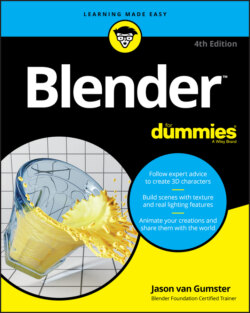Читать книгу Blender For Dummies - Jason van Gumster - Страница 56
VFX
ОглавлениеVisual effects, or VFX for short, is the art of taking existing footage — often captured with a camera, but it could also be animation footage — and modifying it to achieve a particular effect. Maybe you want to make a daytime scene look like it’s happening at night or perhaps you want to put a dragon in footage of your front yard. That’s all VFX and the workspaces in this section are tuned to getting that job done well. Chapters 18 and 19 of this book go into more detail on Blender’s VFX tools.
Compositing: This workspace is the same as the one used in the General category as well as the 2D animation one. Compositing is at the heart of VFX work, so it makes sense to include it among this group.
Masking: If you’re mixing footage together, be it live action or animated, chances are good that you’re going to have to hide or otherwise remove something from the shot, be it the strings on a puppet or an entire house in a neighborhood. You do this with masking, and because you’re dealing with moving images, it’s a more involved process than you might be used to if you’ve only ever done something like that in a single image editor like GIMP or Photoshop. So Blender has a whole workspace dedicated to masking.
Motion Tracking: In VFX, you’re dealing with moving images. To make your 3D assets seamlessly integrate, it’s useful to track the movement in your footage. Blender has a built-in motion tracker, which gives you the ability to track the location of the video camera in 3D space as well as the movement of objects on screen. This workspace is tuned to help you use the motion tracker as effectively as possible.
Rendering: As with most work that you produce in Blender, it has to be rendered to output files that you can share. This workspace is the same one that has been described previously.
